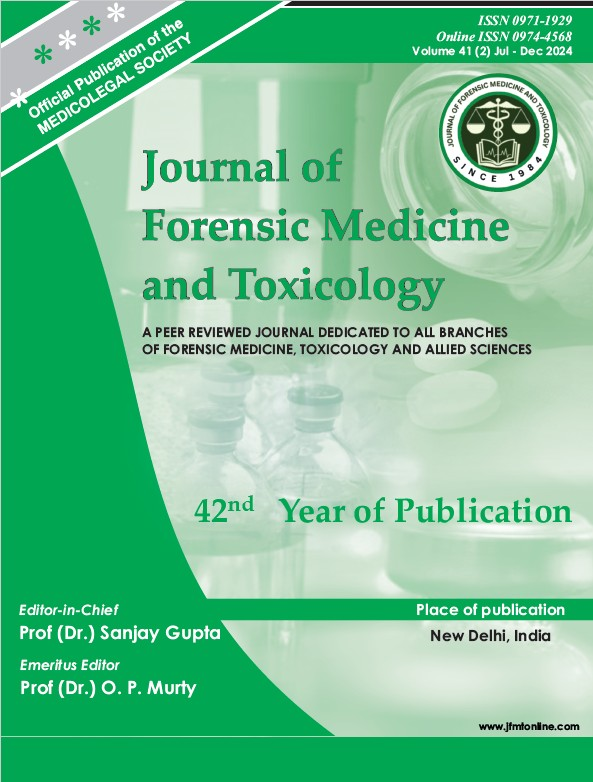ESTIMATION OF SEX FROM ORBITAL INDEX – AN ANTHROPOLOGICAL METRIC BASED STUDY
DOI:
https://doi.org/10.48165/jfmt.2024.41.2.34Keywords:
Forensic Anthropology, Dacryon, Orbital Index, Skull, Sexual Dimorphism, Sex estimationAbstract
Human orbit is one such area where many investigators have a vested interest for its use in identification due to its dimorphic features. Aims and Objectives: To determine sex with the help of orbital index. 2. To analyze and compare the measurements of right and left orbital index in dry skulls and to see their statistical significance. To derive the regression formula of orbital index for sex identification. Materials and Methods: A cross-sectional study was conducted using seventy-two dry skulls (47 males and 25 females) obtained from the departmental museums of Forensic Medicine and Anatomy. The morphometric values were recorded, orbital index was calculated, and all parameters were analysed, followed by independent ‘t’ test and discriminant function analysis.
Downloads
References
Siegel J, Saukko P, Houck M. Personal identification in forensic anthropology. Encyclopedia of Forensic Sciences. 2nd ed. USA: Elsevier Academic Press; 2012: 1077-89.
Prado FB, de Mello Santos LS, Caria PHF, Kawaguchi JT, Ad’OG Preza, Daruge Jnr E, et al. Incidence of clavicular rhomboid fossa (impression for costoclavicular ligament) in the Brazilian population: forensic application. J Forensic Odontostomatol 2009 Jun;27(1):12-6
Reddy KSN. Identification. In, The essentials of Forensic Medicine & Toxicology.34th Ed Hyderabad: Medical Book Company:2017.
Shrestha O, Bhattacharya S, Jha N, Dhungel S, Jha CB, Shrestha S, et al. Craniofacial anthropometric measurements among Rai and Limbu community of Sunsari District, Nepal. Nepal Med Coll J 2009 Sep;11(3):183-5
Pommier S, Adalian P, Gaudart J, Panuel M, Piercecchi-Marti MD, Leonetti G. Fetal age estimation using orbital measurements: 3D CT-Scan study including the effects of trisomy 21. J Forensic Sci 2009 Jan;54(1):7-12.
Ukoha U, Egwu OA, Okafor IJ, Ogugua PC, Onwudinjo O, Udemezue OO. Orbital dimensions of adult male nigerians : a direct measurement study using dry skulls. Int J Biol Med Res. 2011;2(3):688-690
Vij K. Identification. In, Textbook of Forensic Medicine and Toxicology: Principles and Practice 5th Ed New Delhi: Elsevier 2011.35-73p.
T.L. Rogers, Determining the sex of human remains through cranial morphology, J. Forensic Sci. 50 (3) (2005) 493–500 PubMed PMID: 15932077
Bruzek J (2002). A method for visual determination of sex, using the human hip bone. Am. J. Phys. Anthropol. 117:157-168
Sarkar N, Mukhopadhyay PP. Determination of sex from the morphometry of orbits in adult skull of contemporary eastern Indian population. Egyptian Journal of Forensic Sciences. 2018 Nov 13;8(1):61.
Rajangam S, Kulkarni RN, Quadrilos Lydia S, Sreenivasulu S. Orbital dimensions. Indian J Anat. 2012; 1:59
Patil, G. (2014). Study of orbital index in human dry skulls of south Indian origin. Journal of the Anatomical Society of India, 64, p.S1
Mekala D, Shubha R, Rohini M. Orbital dimensions and orbital index: A measurement study on South Indian Dry Skull. Int J Anatomy Res. 2015; 3:1387–91
Biswas, S., Chowdhuri, S., Das, A. and Mukhopadhyay, P. (2015). Observations on Symmetry and Sexual Dimorphism from Morphometrics of Foramen Magnum and Orbits in Adult Bengali Population. Journal of Indian Academy of Forensic Medicine, 37(4), p.346
Maharana, SS. and Agarwal, RK. (2015). Variations in the Dimensions of the Orbit in the Adult Human Skull
(A Dry Bone Study). International Journal of Recent Biotechnology, 3(3), pp. 20-22
Dhanwate AD, Gaikwad MD. Morphometric analysis of orbit in Indian skulls and comparison with international studies. Int J Anat Res 2016;4(4):2896-2901
Giles, E., & Elliot, O. (1963). Sex Determination by Discriminant Function Analysis of Crania. American Journal of Physical Anthropology, 21, 53-68
Krogman, W.M., Iscan, M. Y. The Human Skeleton in Forensic Medicine. Charles C.Thomas, Springfield, IL, 1986
Kokich, V.G. (1976) Age changes in the human frontozygomatic suture from 20 to 95 years. Am J Orthod 69: 411–430
Gopalakrishna K, Kashinatha SM. The craniometrical study of orbital base of Indian population and its applied Importance. Sch Acad J Biosci. 2015;3(7):618-623.
Husmann PR, Samson DR. In the Eye of the Beholder: Sex and Race Estimation using the Human Orbital Aperture. J Forensic Sci. 2011; 56 (6): 1424-1429. http:/ /dx.doi.org/10.1111/j.1556-4029.2011.01864.x
Mukherjee, J.B. (1981) Forensic Medicine and Toxicology. Vol. 1, 2nd Edition, Academic Publishers, Calcutta.
Snow, C.C. (1982). Forensic Anthropology. Annual Review of Anthropology, 11, 97–131. http:// www.jstor.org/stable/2155777
Jeremiah M, Pamela M, Fawzia B. Sex differences in the cranial and orbital indices for a black Kenyan population. Int J Med Sci. 2013; 5:81–4
Fathy, F. and Dalia, M. (2014). Morphometric analysis of the orbit in adult Egyptian skulls and its surgical relevance. Eur. J. Anat, 18(4), pp.303-315
Badiu GA, Tarþa-Arsene E, Ispas AT, Niculae A, Baciu A, Stroicã L. Sex Determination Using the Dimensions of Human Orbits. Romanian Journal of Functional & Clinical, Macro- & Microscopical Anatomy & of Anthropology. Vol. 18(Issue 3): p145-151. 7p.
Sangvichien S, Boonkaew K, Chuncharunee A, Komoltri PH, Piyawinitwong S, Wongsawut A. Sex determination in Thai skulls by using craniometry: Multiple logistic regression analysis. Siriraj Med J. 2007; 59:21621
Botwe, Benard & Sule, Derick & Ismael, Abdul. (2017). Radiologic evaluation of orbital index among Ghanaians using CT scan. Journal of Physiological Anthropology. 36. 10.1186/s40101-017-0145-7.
Kanjani V, Rani A, Kanjani D. Morphometric Analysis of the Orbital Aperture in North Indian Population: A Retrospective Digital Forensic Study. Int J Appl Basic Med Res. 2019;9(2):85–8.




